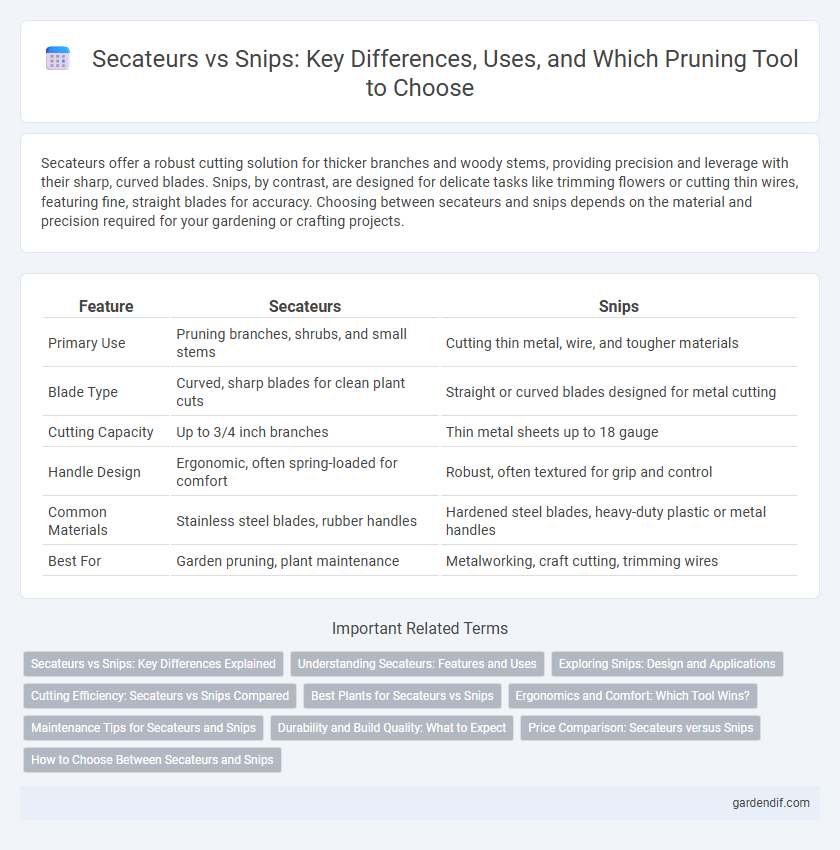
Secateurs vs Snips Illustration
Secateurs offer a robust cutting solution for thicker branches and woody stems, providing precision and leverage with their sharp, curved blades. Snips, by contrast, are designed for delicate tasks like trimming flowers or cutting thin wires, featuring fine, straight blades for accuracy. Choosing between secateurs and snips depends on the material and precision required for your gardening or crafting projects.
Table of Comparison
| Feature | Secateurs | Snips |
|---|---|---|
| Primary Use | Pruning branches, shrubs, and small stems | Cutting thin metal, wire, and tougher materials |
| Blade Type | Curved, sharp blades for clean plant cuts | Straight or curved blades designed for metal cutting |
| Cutting Capacity | Up to 3/4 inch branches | Thin metal sheets up to 18 gauge |
| Handle Design | Ergonomic, often spring-loaded for comfort | Robust, often textured for grip and control |
| Common Materials | Stainless steel blades, rubber handles | Hardened steel blades, heavy-duty plastic or metal handles |
| Best For | Garden pruning, plant maintenance | Metalworking, craft cutting, trimming wires |
Secateurs vs Snips: Key Differences Explained
Secateurs are handheld pruning tools designed for cutting thicker branches up to 3/4 inch in diameter, offering precision and leverage with curved blades, while snips are smaller, lightweight cutters ideal for trimming delicate plants and thin stems. The key difference lies in their blade structure and cutting capacity: secateurs typically have bypass or anvil blades for clean cuts on woody stems, whereas snips feature straight or curved blades suited for fine, detailed cutting. Understanding these distinctions helps gardeners choose the right tool for tasks ranging from heavy pruning to intricate shaping.
Understanding Secateurs: Features and Uses
Secateurs, also known as pruning shears, feature sharp, curved blades designed for cutting live plant material such as branches up to 3/4 inch thick. They typically have ergonomic handles with a locking mechanism for safe storage and are used primarily in gardening and horticulture to promote healthy plant growth by precise trimming. Their design allows clean cuts that prevent damage to stems, unlike snips which are better suited for lighter tasks like cutting flowers or thin wires.
Exploring Snips: Design and Applications
Snips feature short, sharp blades designed for precision cutting of thin metal, wire, and small crafting materials, making them ideal for detailed work compared to secateurs. Their compact design allows for greater control in intricate applications such as jewelry making, electronics, and hobby projects where clean, accurate cuts are essential. Unlike secateurs which are primarily used for pruning plants and branches, snips excel in tasks requiring fine manipulation of tougher materials without crushing or bending.
Cutting Efficiency: Secateurs vs Snips Compared
Secateurs deliver superior cutting efficiency for thick branches up to 3/4 inch in diameter due to their ratcheting mechanism and strong leverage. Snips excel at precision cuts on softer materials like flowers and thin stems, offering fine control but limited power. Choosing between secateurs and snips depends on the specific cutting task and material thickness for optimal performance.
Best Plants for Secateurs vs Snips
Secateurs are ideal for pruning woody plants, shrubs, and small branches, making them perfect for rose bushes, fruit trees, and hardwood stems. Snips excel at trimming delicate herbs, flowers, and soft foliage such as basil, lavender, and leafy greens, allowing precise cuts without crushing. Choosing between secateurs and snips depends on the plant's stem thickness and toughness to ensure clean cuts and healthy growth.
Ergonomics and Comfort: Which Tool Wins?
Secateurs feature ergonomic handles designed to reduce hand fatigue during prolonged use, often incorporating cushioned grips and spring mechanisms that enhance comfort. Snips, while typically lighter and easier to control for precision cutting, lack the same level of ergonomic support, making them less suitable for extensive pruning tasks. Ergonomics and comfort largely favor secateurs in scenarios requiring repetitive or heavy cutting, ensuring better hand protection and reduced strain.
Maintenance Tips for Secateurs and Snips
Regularly clean secateurs and snips after each use to prevent sap build-up and rust, using a damp cloth and mild detergent. Sharpen the blades with a sharpening stone or file to maintain cutting efficiency and reduce plant damage. Apply a light coating of lubricating oil to the pivot points and blades to ensure smooth operation and prolong tool lifespan.
Durability and Build Quality: What to Expect
Secateurs typically feature robust steel blades and ergonomic handles designed for repeated heavy-duty pruning, offering superior durability compared to snips. Snips, while lightweight and precise for cutting thin materials, often have slimmer build quality with less reinforcement, making them less suitable for intense garden tasks. Expect secateurs to maintain sharpness and structural integrity longer, especially under rigorous use, whereas snips excel in finer, less demanding cuts.
Price Comparison: Secateurs versus Snips
Secateurs typically range from $15 to $50, offering durable blades and ergonomic handles ideal for thicker branches, while snips are generally priced between $10 and $30, suited for precise trimming of thinner stems and flowers. The price variation reflects their design complexity and intended use, with secateurs often incorporating advanced cutting mechanisms that justify a higher cost. Comparing costs highlights snips as a budget-friendly option for light garden tasks, whereas secateurs provide greater value for heavy-duty pruning.
How to Choose Between Secateurs and Snips
Choosing between secateurs and snips depends on the type of cutting task and plant material involved. Secateurs are ideal for cutting thicker branches up to 3/4 inch in diameter due to their strong, curved blades and ergonomic handles. Snips are better suited for precision trimming of flowers, herbs, and thin stems, offering control and delicate cuts without crushing the plant tissue.
Secateurs vs Snips Infographic

 gardendif.com
gardendif.com